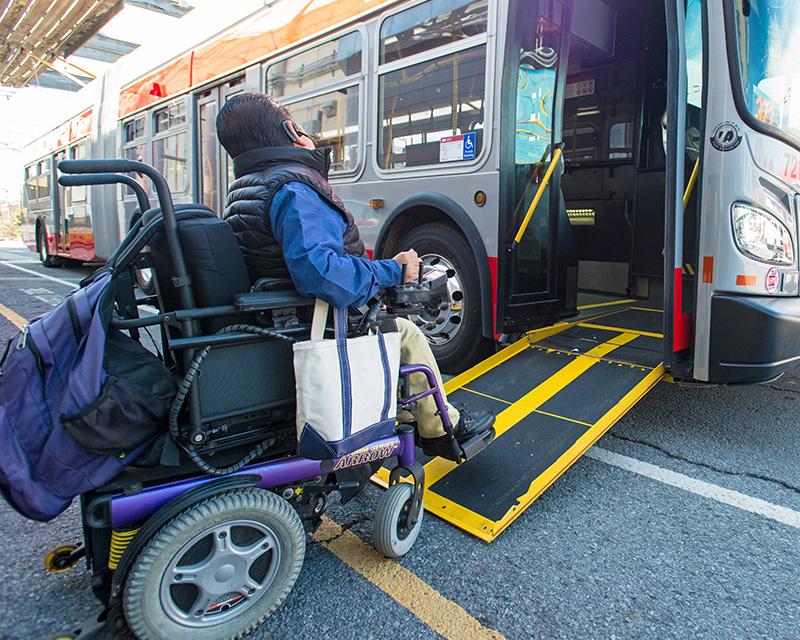Op-ed: Gimme Shelter Muni!
4:35 PM PDT on October 24, 2022

Much progress has been made in helping disabled people use the bus. But let’s not overlook the value of decent bus shelters while they’re waiting. Photo: SFMTA
Note: GJEL Accident Attorneys regularly sponsors coverage on Streetsblog San Francisco and Streetsblog California. Unless noted in the story, GJEL Accident Attorneys is not consulted for the content or editorial direction of the sponsored content.
Public transit does not start once you find a seat (if you are lucky) on the bus. The transit trip starts when you walk, roll, or bike to the bus stop. For seniors and people with disabilities, the distance to the nearest stop is one of four factors that determine if Muni service is accessible. Two other factors are their health and the weather.
Finally, the fourth major reason is the presence of a shelter with seating at the stop.
To see how important shelters and seating are, Senior and Disability Action (SDA) asked 240 seniors and people with disabilities whether a bus shelter was a necessity or just a convenience in using public transit. Forty-two percent said that it was a necessity and an additional 40 percent said that it depends on their health and the weather.
SDA explored further by asking how long respondents can normally stand; 72 percent said no more than 10 minutes. When asked how often they wait for a bus longer than they can comfortably stand, 33 percent stated “often” to “always”. When asked whether seating at a shelter was a necessity or just a convenience, 38 percent considered it a necessity and 39 percent said that it depends on their health and the weather.
A 2021 study, “Are Shelters in Place? Mapping the Distribution of Transit Amenities via a Bus-Stop Census of San Francisco,” revealed that only about a third of stops include shelters with seating, and these are not evenly distributed. That Berkeley Institute of Transportation study found that “census tracts with higher shares of white residents are more likely to feature bus stops with seating, shelters, and clear curbs.” In addition, “those stops which are served least frequently by buses are least likely to provide seating, shelters, or clear curbs.”
SDA’s survey also asked the senior and disability community what impact the distancing of bus stops has on them. Currently, SFMTA bus stop guidelines for streets with less than a 10 percent grade have a distancing range of 800 to 1350 feet between stops where 1350 feet well exceeds two blocks on most San Francisco streets. Of the same 240 people surveyed, 33 percent indicated that they could walk no more than two blocks. Thirty-five percent of the same group indicated that they sometimes had to walk farther than they were physically comfortable in order to reach a bus stop, while 22 percent indicated that this happens “often” to “always”.
When distance and lack of shelter and seating at bus stops becomes too discouraging, people who struggle to ride transit are forced to make difficult choices: stay home and miss that medical appointment, beg a ride, or spend money they don’t have for an alternative.
In September 2021, the San Francisco Municipal Transportation Agency made a promise that it would fully restore Muni by spring 2022. This restoration, entitled “Muni 2022”, would be the first step to envisioning and implementing Muni the Next Generation.
Now it is October 2022 and the SFMTA is continuing to restore Muni to its pre-pandemic service, with some changes that would (in their minds, but challenged by many transit riders) make Muni more affordable and effective. With our Covid-19 pandemic-tired eyes, it appears that significant progress has been made to return us to pre-pandemic Muni. Great! But while route restoration remains a priority, the SFMTA must also acknowledge that many riders lack access to those returning routes and installing shelters with seating is also essential.
I'm not alone in being tired of waiting for the next crowded bus at a bus stop with no shelter or seating.
***
Pi Ra is Transit Justice Program Director at Senior and Disability Action.
Stay in touch
Sign up for our free newsletter
More from Streetsblog San Francisco
Commentary: Merchants Are Getting People Killed
The number one local obstruction to curbing traffic violence is local commerce and merchant groups.



